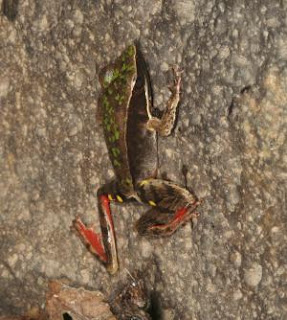Meme Creator
13 years ago


 The food chain is a very important and interesting topic. A food chain is a chain that expresses organisms and what their food habits are. A food web is many different food chains collided and mixed in one. There are three types of consumers: herbivores which only eat vegetation, carnivores which only eat meat, and omnivores which eat both. A food chain starts wit a producer such as a plant. Then a consumer such as a grasshopper, this is called a primary consumer. Primary consumers are usually herbivores. Then usually its a larger organism, which eats the primary consumer which is known as the secondary consumer. Secondary consumers are usually carnivores or omnivores, such as a frog. Next comes a tertiary consumers, then so on and so forth. The end of the food chain is conquered by organisms which are called decomposer which literally decompose other dead organisms and return them to the soil. An example is a mushroom. So a food chain is producer---> primary consumer---> secondary consumer-----> a tertiary consumer---> decomposer.
The food chain is a very important and interesting topic. A food chain is a chain that expresses organisms and what their food habits are. A food web is many different food chains collided and mixed in one. There are three types of consumers: herbivores which only eat vegetation, carnivores which only eat meat, and omnivores which eat both. A food chain starts wit a producer such as a plant. Then a consumer such as a grasshopper, this is called a primary consumer. Primary consumers are usually herbivores. Then usually its a larger organism, which eats the primary consumer which is known as the secondary consumer. Secondary consumers are usually carnivores or omnivores, such as a frog. Next comes a tertiary consumers, then so on and so forth. The end of the food chain is conquered by organisms which are called decomposer which literally decompose other dead organisms and return them to the soil. An example is a mushroom. So a food chain is producer---> primary consumer---> secondary consumer-----> a tertiary consumer---> decomposer.





 The frogs that seek the help to other creatures in the environment. These amphibians are the victims to fungus, which are endangering the life of these frogs. Scientists across the world are are finally learning about the loss of these frogs. One of the problems with these amphibians endangered is that they help the food chain. They help by keeping the base of the food chain which is algae, productive. All the other organisms depend on other organisms for the food. If the base is affected the whole food chain is affected. which in this case is very bad. The research in University of Georgia has proven that the production of algae is more productive when tad poles were used in the experiments. frogs also keep the stream healthy. The chytrid fungus that is responcible for this has traveled southeast across Costa Rica and through much of Panama killing 90 percent of frogs in the streams. But scientists can cure individual frogs by simply swabbing them with a fungicide. But help across the globe is needed zoos and such. I think that we should help these frogs and help our selfs and make the food chain more productive.
The frogs that seek the help to other creatures in the environment. These amphibians are the victims to fungus, which are endangering the life of these frogs. Scientists across the world are are finally learning about the loss of these frogs. One of the problems with these amphibians endangered is that they help the food chain. They help by keeping the base of the food chain which is algae, productive. All the other organisms depend on other organisms for the food. If the base is affected the whole food chain is affected. which in this case is very bad. The research in University of Georgia has proven that the production of algae is more productive when tad poles were used in the experiments. frogs also keep the stream healthy. The chytrid fungus that is responcible for this has traveled southeast across Costa Rica and through much of Panama killing 90 percent of frogs in the streams. But scientists can cure individual frogs by simply swabbing them with a fungicide. But help across the globe is needed zoos and such. I think that we should help these frogs and help our selfs and make the food chain more productive.